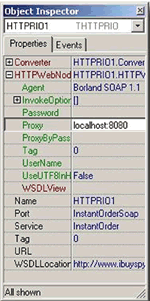|  SOAP
And Web Services SOAP
And Web Services
 Debugging
SOAP Data Debugging
SOAP Data
Abstract
This article shows you how you can see the SOAP data passed
from and to your SOAP application (Delphi 6 Enterprise).
Introduction
I assume you already know how this SOAP business works, and
how to write your basic SOAP server, your basic SOAP client
etc. But let's say you're foxed about certain things, and
you need to see the SOAP packet being passed from and to your
application. I'm assuming that you're building a SOAP client
in Delphi, and you're connecting to some SOAP server - which
is potentially somewhere "out there". I will proceed
to discuss TWO ways to get to the SOAP packets.
1) Using ProxyTrace:
First, get ProxyTrace from http://www.4s4c.com/tcptrace/pt.asp.
Now, run it, on say port 8080 (which is the default). Then,
simply go to Delphi and set your HTTPRio's HTTPWebNode.Proxy
property to "localhost:8080". Like this:

Note: If you're
running Delphi 7 with Indy, you need to set the proxy to “http://localhost:8080"
or Indy won't be able to parse the text properly. Thanks to
Joe Rykowski for this tip.
Run your application and you
can actually see the data going back and forth like this:

Of course, remember to remove
that proxy setting when you're done with your testing, or
your application will refuse to work if the proxy isn't running.
2) From within Delphi:
"No", you say, "I want to manipulate the actual
data sent and received". Well, after you apply Update
Pack 2, you have an easy way to do this. Update Pack 2 is
available at http://www.borland.com/delphi/webreg/d6/d6_registeredusers.asp.
You can use the events BeforeExecute
and AfterExecute to do what you want:
procedure TForm1.HTTPRIO1BeforeExecute(const
MethodName: String;
var SOAPRequest: WideString);
begin
Memo1.Lines.Text := SoapRequest;
end;
procedure TForm1.HTTPRIO1AfterExecute(const MethodName:
String;
SOAPResponse: TStream);
begin
SoapResponse.Position := 0;
Memo2.Lines.LoadFromStream(Soapresponse);
end; |
Points to be noted:
1) The BeforeExecute
gives you a string, the AfterExecute gives
you a Stream. (Note: I do not make the rules)
2) In the AfterExecute
we have to set the SoapResponse.Position to 0. When you get
this stream, it's currently positioned at the end of the stream.
I expect this to be fixed in the next service release, but
no big deal for us really.
This should be even more clear from this source code at http://www.agnisoft.com/download
(ReqResp.zip)
-------------------------------------------------------------------------------------------------------
|
